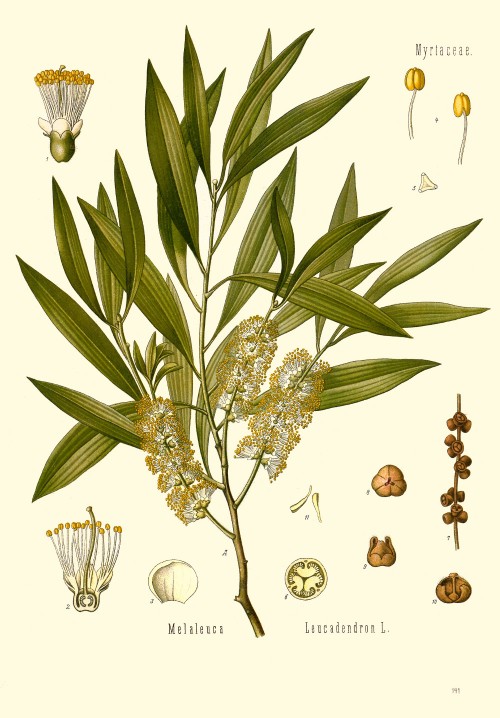Dies ist eine alte Version des Dokuments!
Melaleuca leucadendra (L.) L. - syn. Melaleuca leucadendron L.; Kajuputi leucadendra (L.) Rusby - Myrtaceae
weeping paperbark, longleaf paperbark, cajeput tree, river teatree, swamp teatree, Cajeputbaum
Evergreen tree, up to 30m high, native to Indonesia, Malaysia and Australia; bark white, papery; leaves linear; flowers green/cream/white.
http://florabase.dpaw.wa.gov.au/browse/profile/5932
http://en.wikipedia.org/wiki/Melaleuca_leucadendra
Cajeput oil is a volatile oil obtained by steam distillation from the leaves of Melaleuca leucadendra. https://de.wikipedia.org/wiki/Cajeput%C3%B6l
„The majority of the oil is produced on the Indonesian island of Sulawesi. The name “cajeput” is derived from its Indonesian name, kayu putih (white wood).“ http://en.wikipedia.org/wiki/Cajuput_oil
„Commercial cajuput oil is mainly derived from M. cajuputi subsp.cajuputi. The oil of this taxon mostly, but not always, contains substantial amounts of 1,8-cineole (3–60%), and the sesquiterpene alcohols globulol (trace–9%), viridiflorol (trace–16%) and spathulenol (trace–30%). Other compounds present usually in significant quantities are limonene (trace–5%), ß-caryophyllene (trace–4%), humulene (trace–2%), viridiflorene
(0.5–9%), α-terpineol (1–8%), a- and ß-selinene (each 0–3%) and caryophyllene oxide (trace–7%). This oil will hereafter be referred to as ‘type’ oil. The aromatic ether, cajeputol appears to be absent from the oil of this subspecies. Oil yield ranges from 0.4% to 1.2% (w/w%, fresh weight). The essential oil of M. cajuputi
subsp. cumingiana is highly variable in character. The main components reported in oil from Indonesia, Malaysia, Thailand and Vietnam (non-or low-1,8-cineole forms) are γ-terpinene (0–19%), and terpinolene (0–22%)… The essential oils of M. cajuputi subsp.platyphylla occur in two chemotypes. Typically, the oils contain significant quantities of α-pinene (34–73%), with lesser amounts of 1,8-cineole (0.2–3%), γ-terpinene (trace–2%), p-cymene (trace–1%), terpinolene (trace–1%), ß-caryophyllene (2–14%), aromadendrene (1–9%), humulene (1–7%), viridiflorene (trace–3%), caryophyllene oxide (trace–2%), globulol (trace–6%), viridiflorol (trace–2%), spathulenol (trace–3%) with an absence of cajeputol.“
[Tea Tree: The Genus Melaleuca. Southwell, I.A., Lowe, R.F., Series Medicinal and Aromatic Plants, Industrial Profiles, 1999, vol. 9, 228]
Cajeput oil is used in aromatherapy and as an antiseptic in nose drops.
[Medicinal Plants of the World. Ben-Erik Van Wyk and Michael Wink, Pretoria 2004, 202]

Köhler,F.E., Medizinal Pflanzen, vol.2, t.141 (1890)
http://plantgenera.org/species.php?id_species=652450
